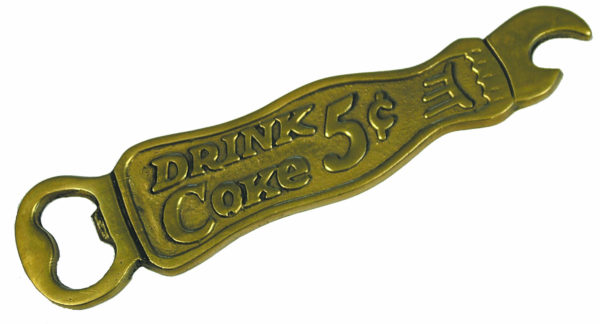After a promising start, the Coca-Cola Company continued to grow.
In 1894 Mississippian Joseph Biedenharn noticed the rapid increase in sales of Coca-Cola in his candy store and soda fountain. Because of this demand for the popular drink, he decided to install bottling machinery in the rear of his store. Biedenharn recognized that many people did not have easy access to the thirst-quenching drink. Textile mill workers, farmers and lumber mill employees would all certainly enjoy the drink on a hot Mississippi summer day.
He placed the syrup in a common, straight-sided glass bottle called a Hutchinson. Once capped, the bottles were loaded into a mule or horse drawn wagon and distributed to customers up and down the Mississippi River. He felt that people should have their favorite refreshment with them wherever they were. Biedenharn sent 12 of the bottled drinks to Asa Candler, but Candler was not impressed. Candler did not realize that the heart of Coca-Cola would be with portable, bottled beverages that customers could take anywhere.
Five years later in 1899, when two lawyers from Chattanooga, Tennessee, Benjamin F. Thomas and Joseph B. Whitehead, recognized the impact that bottling could have on the future sales of Coca-Cola, they secured from Asa Candler the exclusive right to bottle and sell Coca-Cola in practically the entire United States. Chattanooga businessman John T. Lupton soon joined forces with the bottlers. This was the beginning of what is today the worldwide bottling system. It was only when a strong bottling system developed that Coca-Cola became the world famous brand it is today.
Thomas, Whitehead and Lupton realized that the three of them could not expand the company with their current monetary and employee limitations. They could not do it by themselves. In order to accomplish expansion and for it to be profitable financially, they would have to divide the nation into territories. Mr. Whitehead moved to Atlanta, opened a plant in that city in the spring of 1900 and founded the Dixie Coca-Cola Bottling Company, a parent bottling organization, which took original jurisdiction over the southeast, southwest and midwest. Mr. Thomas remained in Chattanooga, looking after the heavily populated eastern and Mid-Atlantic states and the Pacific Coast. His parent bottler operation was to become The Coca-Cola Bottling Co. (Thomas) Inc. Mr. Lupton continued to reside in Chattanooga as the associate of J.B. Whitehead.
The three pioneer bottlers sold bottling rights to local entrepreneurs. Their efforts were boosted by major progress in bottling technology. Realizing that they needed to seek outside capital, they contracted with competent individuals to establish Coca-Cola bottling operations within certain defined geographic areas.
After Lupton opened the first plant in Chattanooga in 1899, Whitehead would open the bottling plant in Atlanta. Lupton was the brother-in-law of Luther Snyder who purchased the Charlotte, North Carolina territory that included the South Carolina counties of York and Chester. Snyder would later sell the York County territory to William M. Mauldin. His father-in-law, A.D. Crisman, had served as manager in the beginning years.
By late 1913 and early 1914, there developed a need for an association to represent the bottlers. A group of 25 bottlers of Coca-Cola formed the Coca-Cola Bottlers Association. Its legal counsel was Harold Hirsch, general counsel for Coca-Cola Company. First officers were Crawford Johnson of Birmingham, President; J.C. Pidgeon of Memphis, Vice President; Arthur Montgomery of Atlanta, Secretary and Treasurer. One of the first jobs of the association was to conduct a contest for a standard design bottle. The design award went to the Root Glass Bottling Company. The company was selected from among eleven designs in a national competition. The bottle, designed after the image of a coca tree pod, was patented November 16, 1915, but it wasn’t until 1977 that the U.S. Patent and Trademark Office recognized the contour bottle as a trademark. Chapman J. Root, T. Clyde Edwards, Earl R. Dean and Alexander Samuelson of the Root Glass Bottling Company in Terre Haute, Indiana designed the 6.5 fluid ounce Coca-Cola bottle.

